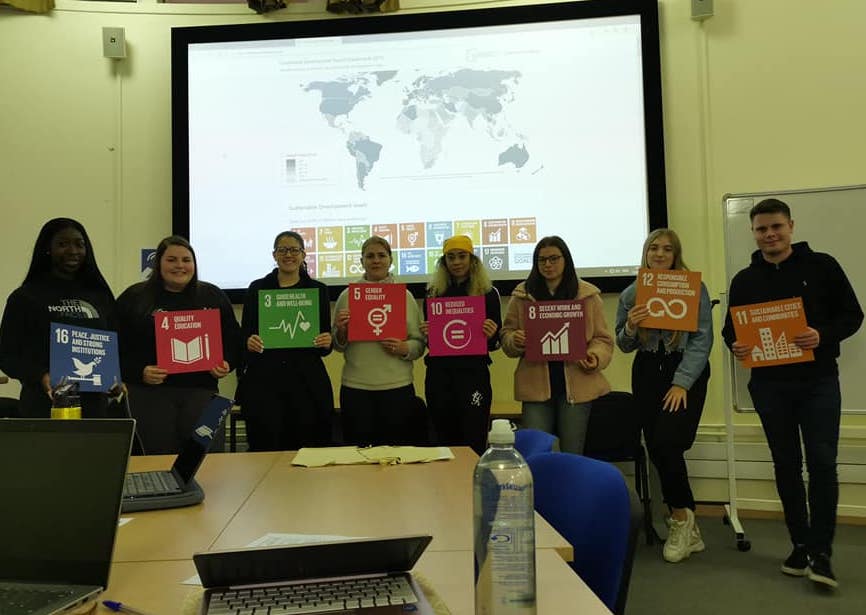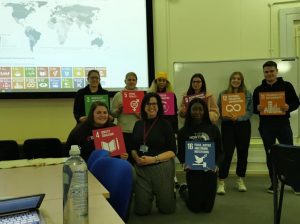This case study describes how Teacher Fellow Di Turgoose incorporates the SDGs when teaching about Domestic Abuse.
“I am #proudtobemore co-creating with students on the public good in pursuit of eliminating domestic abuse utilising the SDGs. I could not be prouder of the student team.” – Di Turgoose, Module Leader
What was the programme or module? ‘Domestic Abuse’ which is a 2nd year undergraduate elective module (15 credits) within the following programmes: Criminology; Psychology with Criminology; Criminal Investigation with Policing; Policing Studies. There are typically 50 students per semester.
What happened?
Overview: The ‘Domestic Abuse’ module covers the varying context, nature, signs, triggers and impacts of domestic abuse through critical evaluation of theoretical perspectives, discussion around relevant policy and best practice, and examines the interconnection of diversity such as race, culture, gender, sexuality, religion, sexuality and disability. The module also highlights social & health care responsibilities alongside developments within legal criminal & civil proceedings. During my workshops with students, I used an active constructivist approach to first introduce all of the SDGs, and then after a reflective break and we discuss the application of the SDGs to our subject area.
Context: During the first week of classes, we had a flat classroom set up for group working and around 50 people were in the room. The SDGs were put up in class for the 2nd year module along with the following questions: What do we know? What don’t we know? A comments/enquiry box was also used for anonymous questions to prevent a barrier to participation. I then introduced the independent task based on a constructivist approach that students actively research all SDGs – I provided the relevant UN documents and placed the world map link onto the module shell – this was for us to discuss and reflect on during SDG teach-in which is week 21 (week 7 of module content).
Description: In week 21 (week 7 of module content), students presented their feedback and we discussed all of the SDGs and made reference/comparisons to countries on the map. Some interesting discussions arose for example about the UK and Norway such as the UK not meeting green for gender equality. We considered the relevance and interconnectedness of the SDGs with Domestic Abuse – first individually, then in pairs, then in small groups feeding back to the whole group. We concluded with an agreement on which SDGs relate best to the module. This year was the first year I had used the visual cards representing each of the SDGs.
Evaluation: Students acting as ‘researchers’ was extremely successful in terms of awareness and engagement and in moving towards action and pledging.
“I love this type of inspiring interactive style of lecturing, it helps us to see the complex nature of the problem of domestic violence and abuse and how we can make links between theory policy and practice.” – Student feedback
Next steps: I will be presenting these outcomes to my own team and to the School Learning and Teaching Group (SLTG) in Applied Social Sciences for others to comment on the feasibility for adoption/application to their own subject specialisms. I would very much welcome future collaboration with others teaching this subject area across the University.
Which SDGs link to this subject? Multiple SDGs are connected to Domestic Abuse: SDG 1 no poverty; SDG 3 wellbeing; SDG 4 quality education; SDG 5 gender equality; SDG 8 decent work; SDG 10 reduced inequalities; SDG 11 sustainable cities; SDG 12 responsible consumption.
Students highlighted the most obvious SDGs relating to the module (SDG 3, SDG 10, SDG 5) and also chose to apply SDG 11 in relation to production such as no to puppy/kitten farming/breeders which is linked to ‘pet’ consumption – there is a link between pet abuse and domestic violence and abuse and this was a pivotal connection being made by students.
Moreover SDG 16 Peace, Justice and Strong Institutions links to other SDGs and helps with seeing things in a wider context, providing further provocation for critical thinking. For example, SDG 16 looks at gender based preventive violence initiatives in institutions which can be linked to education such as schools and to Universities, including the Mandala project at DMU.
Why are the SDGs important to this subject? SDGs enable reflection on action in relation to the real world problem of domestic violence and abuse in its many forms, and prepares the students for action with regard to pledging a commitment to highlighting the extent of domestic violence and abuse both locally, nationally and internationally.
What went well? The use of visual cards in semester 2 really helped the discussion. Whilst the anonymous box for questions worked well, I would want to incorporate more visual tools such as mentimeter in future. The classroom set up needs to be conducive to group work which required some planning but it worked extremely well. Access to nearby computers was needed to enable the research activity.
Contact: Teacher Fellow Di Turgoose. Module Leader Domestic Abuse. Co Convener of Domestic and Sexual Violence Research Network at DMU. School of Applied Social Sciences. Faculty of Health and Life Sciences. Email: di.turgoose@dmu.ac.uk. Telephone number: 0116 257 7281
This post is one of a series of case studies describing teaching and learning activities linked to the SDGs at DMU.


Leave a Reply